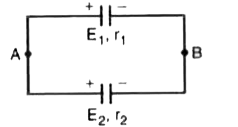Two cells of unequal e.m.f. E1 and E2 and internal resistances r1 and r2 are joined as shown. VA and VB are the potentials at A and B respectively :

one cell will continuously supply energy to the other
the potential difference across both the cells will be equal
the potential difference across one cell will be greater than its e.m.f.
VA−VB=(E1r2+E2r1)(r1/r2)
The correct Answer is:A, B, C, D
If E2>E1
∴ current in the circuit= I=−E1+E2r1+r2 …(1)
∴VA−VB=P.D across each cell=E1+Ir1 …(2)
∴VA−VB>E1(∵V=E+Ir During Charging V>E) (Using (1) in (2))
We get VA−VB=E1r2+E2r1r1+r2
Topper's Solved these Questions
- CURRENT ELECTRICITYBOOK - MODERN PUBLICATIONCHAPTER - CURRENT ELECTRICITYEXERCISE - MULTIPLE CHOICE QUESTIONS (PARAGRAPH QUESTIONS)
2 Videos
- CURRENT ELECTRICITYBOOK - MODERN PUBLICATIONCHAPTER - CURRENT ELECTRICITYEXERCISE - MULTIPLE CHOICE QUESTIONS (LEVEL-II)
8 Videos
- CURRENT ELECTRICITYBOOK - MODERN PUBLICATIONCHAPTER - CURRENT ELECTRICITYEXERCISE - RECENT COMPETITIVE QUESTIONS
32 Videos
- ATOMS, MOLECULES AND NUCLEIBOOK - MODERN PUBLICATIONCHAPTER - ATOMS, MOLECULES AND NUCLEIEXERCISE - Recent Competitive Questions
40 Videos
- DESCRIPTION OF MOTION IN ONE DIMENSION BOOK - MODERN PUBLICATIONCHAPTER - DESCRIPTION OF MOTION IN ONE DIMENSION EXERCISE - Revision Test
45 Videos
Similar Questions
Two cells of unequal emfs ε1 and ε2, and internal resistances r1 and r2 are joined as shown. VA and VB are the potentials as A and B respectively.

View SolutionTwo batteries of e.m.f. E1 and E2 and internal resistance r1 and r2 are connected in parallel. Determine their equivelent e.m.f.
View Solution
Knowledge Check

Two cells of unequal emfs, ɛ1 and ɛ2 and internal resistances r1 and r2 are joined as shown. VA and VB are the potentials at A and B respectively.AOnce cell wil continuously suply energy to the other.BThe potential difference across botht eh cells will be equal.CThe potential difference across one cell will be greater than its emf.DVA−VB=(ɛ1r2+ɛ2r1)(r1+r2)Two cells of unequal emfs ε1 and ε2, and internal resistance r1 and r2 are joined as shown. VA and VB are the potential at A and B respectively.

(i) One cell will continuously supply energy to the other
(ii) The potential difference across both the cells will be equal
(iii) The potential difference across one cell with be greater than its emf.
(iv) VA−VB=ε1r1+ε2r2r1+r2.A(i),(ii)B(ii),(iii)C(i),(iv)DallTwo cells of the same e.mf. e but different internal resistances r1andr2 are connected in series with an external resistance 'R'. The potential drop across the first cell is found to be zero. The external resistance Ris
 Ar1−r2Br1r2Cr1r2Dr1+r2
Ar1−r2Br1r2Cr1r2Dr1+r2
Two batteries of e.m.f. E1 and E2 and internal resistance r1 and r2 are connected in parallel. Determine their equivelent e.m.f.
View SolutionTwo cells of emf E1 and E2 have internal resistance r1 and r2. Deduce an expression for equivalent emf of their parallel combination.

View SolutionSTATEMENT-1 : If two cells of emf E1 and E_(2)(E_(1) cancel(=) E_(2)) and internal resistace r1 and r2 are joined together as shown, then one cell will continuously supply energy to the other.

and
STATEMENT-2 : The potential drop across one cell will be larger than other
View SolutionTwo batteries of emf E1andE2(E2>E1) and internal resistances r1andr2 respectively are connected in parallel as shown in figure.

View SolutionA circuit consists of two cells, each of e.m.f. E and internal resistances r1 and r2 are connected in series through an external resistance X. If the potential difference between the ends of the first cell is zero, the value of X in terms of r1 and r2 will be
View Solution
